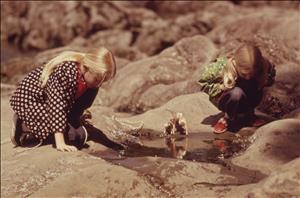When shipbuilder and former Seattle Mayor Robert Moran offered to donate a vast tract of land on Orcas Island to the State of Washington around 1910, it was thought that Washington's first state park would soon be established on Moran's property. Instead, Moran's bid was ensnared in red tape while two smaller properties – one in Whatcom County, one in Lewis County – were donated to the state and approved as state parks in 1915. The first was Larrabee State Park, created after Frances Larrabee donated 20 acres of land in the Chuckanut Mountains near Bellingham. The second was the Jackson House near Chehalis; built in 1850, the building had served as a post office, general store, tavern, hotel, and courthouse. In 1852, settlers met there and voted to petition Congress to create Washington Territory. Moran would have to wait until 1921 before Moran State Park, a 2,700-acre wonderland, finally opened on Orcas Island.
Munificent Moran
In 1905, former Seattle mayor and shipbuilding magnate Robert Moran (1857-1943) learned he had only a few months to live. Resolved to spend his last days peacefully, he sold his business interests for $3.5 million ($126 million in 2025 dollars) and moved to Orcas Island, where he eventually acquired about 7,000 acres of forest, lakes, and saltwater shoreline that included Mount Constitution, the highest point in the San Juan Islands. Having frustrated the predictions of his demise (he lived until 1943), around 1910 Moran invited University of Washington history professor and The Mountaineers member Edmond Meany (1862-1935) to visit him at Rosario, the maritime-inspired Arts and Crafts mansion he built on the shores of East Sound. Firmly wedded to the notion that nature was a place for physical and spiritual rejuvenation, Moran told Meany he wanted to donate his land as a park for the people of Washington.
In autumn 1912, Meany and Moran convinced a delegation of state legislators and university administrators to come to Orcas and assess the park potential of Moran’s holdings. Although the group was impressed, state Sen. Ralph Nichols told Moran there was no obvious agency in state government to accept, much less manage such a park. Moran kept trying, inviting the editor of the Seattle Post-Intelligencer to visit Orcas and lobbying the district’s state representative, V. J. Capron (1868-1934), to introduce legislation to create a state agency for parks.
In 1913, Capron sponsored a bill, successfully creating a State Board of Park Commissioners, composed of the governor, secretary of state, state land commissioner, state auditor, state treasurer, and one other person appointed by the governor. Now Washington had a State Park Board, but the group only had authority to accept donations of land for parks and to recommend the purchase or condemnation of land for parks by the state legislature. It was enough to get started, though, and in 1915 the State Park Board accepted its first two donations of small properties.
Larrabee's Gift
In October, Frances Larrabee (1867-1941), a prominent Bellingham social activist and president of the Pacific Realty Company, donated 20 acres of land in the Chuckanut Mountains, bisected by the Great Northern Railway line, for a park. Governor Ernest Lister in 1913 had asked Larrabee's husband, Bellingham real estate magnate Charles Larrabee (1843-1914) to donate land for a state park along Chuckanut Drive, a scenic route along Samish and Bellingham bays. Larrabee agreed but died before the donation could be completed, and his wife completed the deal.
The next month, the Park Board accepted land and a small log cabin along Highway 99 in Lewis County that had belonged to John R. and Matilda Jackson, Oregon Trail emigres who married in 1848 and were among the first Euro-American settlers north of the Columbia. In 1850, the Jacksons built a cabin along the Cowlitz Trail, a Native American path between the Columbia River and Puget Sound. As more people migrated west, traffic on the Cowlitz Trail increased. Jackson’s home served as a post office, general store, tavern, hotel, and court. Jackson held a variety of roles, including justice of the peace, tax collector, sheriff, assessor, and territorial representative. In 1852, people who had settled north of the Columbia River met at the Jacksons’s house and agreed to ask Congress to establish a Washington Territory independent of Oregon. Washington Territory was created on March 2, 1853.
Five years after John died in 1873, Matilda moved into a newer home on the property and the cabin moldered. In 1914, local resident and Jackson descendant Anna Koontz proposed preserving the cabin as a project for the St. Helens Club of Chehalis, a civic group to which she belonged. The club raised $500 to help restore the house, and the owner of the property offered the cabin and surrounding land to the state to be used as a park. Local workers salvaged materials from the structure and in about three months rebuilt the house to look as it did in 1850, finishing in October 1915. About seven weeks later, the Washington State Board of Park Commissioners accepted the property as the second state park.
Moran, though, had to be patient. Although he had successfully advocated for the creation of the State Park Board, the committee did not accept his proposed gift, perhaps because Orcas Island was remote from most of the population of Washington or because managing so much land posed logistical and financial challenges. It took another six years before the state would accept Moran’s donation, and only then after the legislature expanded the park board’s powers. Renamed the State Parks Committee and given a $50,000 appropriation, it could now acquire new parks, provide camping, and contract with concessioners to raise funds. The system quickly expanded from the initial 20-odd acres to more than 5,500 acres by September 1922, including nearly 2,700 on Orcas Island donated by Robert Moran.

